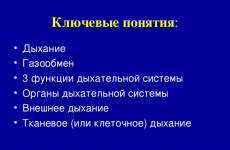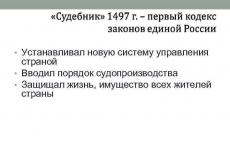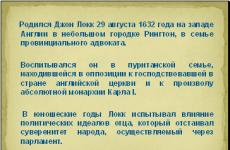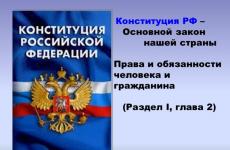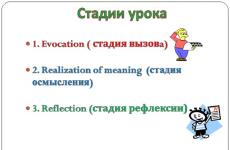Interesting presentations on archeology. Archeology - Historians' Assistant What does archeology study? How do archaeologists work? The presentation was compiled by the teacher of history and social studies, Alexander Smirnov. Ancient cities and settlements
What is the use of archeology? Many objects that people used in ancient times are now under a thick layer of earth. These items help to restore the life of people in the distant past (about which there is no written evidence) Therefore, it is necessary to excavate.

Archeology is the science of antiquity. The Greek word "archeo" means "ancient" and "logos" means a word, science. Archeology is a science that studies the life of people in antiquity, according to the preserved material monuments (material, written and pictorial historical sources)

The main occupation of archaeologists is excavation Archaeologists excavate (it is very hard work), patiently removing the earth layer by layer. It is very important to accurately determine the position of the object in a certain layer of the earth. This helps to establish the time of its appearance (date it). Excavations allow you to extract from the ground tools, weapons, human remains, remnants of dwellings, shards of dishes and much more. What kind of historical sources does the above refer to?





How do archaeologists work? Written historical sources are also preserved underground. During excavations of later layers, clay tablets, stone plates are found, on which ancient inscriptions have been preserved, containing information about events, rulers, laws, and everyday life of people. The oldest manuscripts date back to the 2nd century. BC. Determine how many centuries and years they have lain in the ground.



Found items are studied in archaeological laboratories. Thus, archaeologists not only dig, but also extract historical information from the material they have mined, on the basis of which they compile reports on archaeological expeditions (descriptions). Archaeologists transfer the studied items to museums, where some of the historical sources are kept. Where else besides museums are historical sources kept? Right! In archives and libraries.

Thanks to the preserved remains of people, mummies, ancient images, we know what our ancestors looked like. Scientists have learned how to restore the faces of ancient people from their skulls. The study and restoration of the physical appearance of ancient people is the science of anthropology.




Questions for self-examination: 1. What does the word "archeology" mean in Greek? 2. Why is archeology needed, what benefits does it bring for the study of history? 3. Archeology - what is it? 4. What do archaeologists do? 5. Where are the archaeological materials studied? 6. Where are the studied antiquities transferred?

"Classes for children" - Plan-diagram of observations of the pedagogical process. The effectiveness of the choice of techniques and methods of education and training. Organization of the subject environment. 12. Techniques and methods of moral education. 13. The level of formation of moral qualities in children. 14. Scheme of the teacher's analysis of his own pedagogical activity.
"Music lessons" - Classification of modern methods in musical correction of children with PDA: Any change in the environment can cause panic, irritation, or make the child withdraw into himself. Methods aimed at response, as well as emotional activation; Training methods that are used in the context of behavioral therapy; Relaxation methods; Communicative methods; Creative methods in the form of instrumental, vocal, physical activity.
"Classes on the development of speech" - In the lesson, the main speech problem is solved. Education ZKR. Cultural linguistic environment. Methods for the development of coherent speech: The leading forms are: Art, music, theater. Fiction. Classes in other sections of the program. Formation of the grammatical structure of speech. An important form of work on the development of speech is the lesson:
"Correctional lessons" - The psychological background of the correctional process is: Use of repeated instructions, exercises. Topic: "The role of the teacher's professional competence in the formation of the quality of knowledge of students in special education classes (7 types)." Pedagogical conditions for the organization of correctional work with children in the classes of compensatory education.
"Physics lessons" - An important role is given to the visualization of physical processes; USE OF COMPUTER TECHNOLOGIES WHEN CARRYING OUT LABORATORY WORKS in 7 classes. Advantages of blocks. When preparing graduates for the final certification. Pages for my students: Objective. "Getting ready for tests and tests." In educational activities.
"Classes in mathematics" - G. Galilei. Leonardo da Vinci. S. D. Poisson. A.N. Whitehead. M.V. Lomonosov. A.N. Kolmogorov. N. Wiener. The supreme purpose of mathematics is to find hidden order in the chaos that surrounds us.
- Performed:
- Pashina Alina,
- student of 6-b grade GBOU SOSH № 3
- g. Chapaevsk of the Samara region
- Head: Lyutova O.A.,
- Art teacher
- Archeology is a branch of historical science that studies the past of mankind from material sources. Archeology includes the remains of ancient settlements, sites, settlements, cities, traces of farms, burial grounds, cult objects, treasures, finds of ancient things.
- Archaeologist Is a scientist who studies the past of mankind from material sources.
- Material sources are tools of production and created with their help: buildings, weapons, jewelry, dishes. ... ... The profession of an archaeologist is often compared to the labor of a surgeon - in both cases, one wrong movement with a knife can lead to the death of a patient. Of course, in most cases, archaeologists are not wielding a knife, but a shovel, scoop, spoon, and even an ordinary toothbrush.
- Since the activity of an archaeologist is associated with frequent excavations in different climatic conditions, good physical fitness and endurance are required, as well as the absence of allergic reactions to various organic materials. Due to long archaeological expeditions, a person of this profession must also be emotionally prepared, calm and balanced, because the work can be both individual and in a team.
- The profession of an archaeologist was popular in ancient Rome and Greece. Even then, people knew about the Stone, Bronze and Iron Ages, carried out excavations and found ancient architectural monuments. Archeology as a science was formed only at the beginning of the 20th century and today it represents sections that study various areas of cultures and eras.
- The Archaeological Museum in Istanbul is one of the largest in Europe. Founded in 1846. Located on the slope of one of the seven hills of Istanbul, near Topkapi Palace, Hagia Irene Church and Hagia Sophia Temple.
- Real written
- Material sources are items that people have preserved or found as a result of archaeological excavations. These include: tools, jewelry, dishes, treasures (coins), clothing, huts (estates). ... ...
- In the center of Samara, grandiose archaeological excavations are being carried out. A unique historical site - a fortress from the beginning of the 18th century - lay under the cultural layer of the life of the townspeople for the last one and a half centuries. Excavations were carried out for several years, scientists managed to unearth fragments of an earthen fortress built in the Peter the Great's era and the structures located on its territory. Now, on the spot, they are clearing the preserved wooden structures of the 18th - 19th centuries. The structures will undergo conservation, which will allow them to be preserved as a valuable monument of the cultural heritage of ancient Samara.
- The recognized leader is the Moscow Archaeological Institute, which was founded in 1907 and currently has branches in several cities of the European part of Russia.
- Moscow State Pedagogical University. Faculty of History (founded in 1900), Department of History of the Ancient World and the Middle Ages.
- Volga State Social and Humanitarian Academy. The Faculty of History of the Academy is one of the oldest in the university. Throughout the history of the university, the unit was the basis of the historical-economic, historical-philological and historical-English faculties. In 1987, the Department of Archeology was opened at the Faculty of History under the leadership of I.B. Vasiliev.
- Since 1990, the Volga Archeology Museum has been functioning as a full-fledged educational unit of the University. Since that time, the museum has been expanding its expositions and begins a full-fledged reception of visitors.
- Secrets are kept underground
- All ages and all ages.
- But of course someone brave
- I am always ready to reveal them.
- Whose is this sword and whose is this fang?
- Who can answer instantly?
- Neither biologist nor zoologist
- And, of course, an archaeologist!
- For history to open,
- They are looking far away.
- Surprise us with a find
- Bit by bit the whole era,
- They will create easily.
- They find a treasure of our ancestors,
- And they give it to us.
- 1. Great Russian Encyclopedia. In 30 volumes. Vol. 2.- p. 315-325
- 2. Journal of Children's Encyclopedia. Science archeology
- 3.http: // kayrosblog.ru/
- 4.http: //journaluga.ru/
- 5.http: //liveinternet.ru/
- 6.http: //pgsga.ru
- 7.http: // myshared /
1. Archeology and its place in the system of sciences.
2. Archaeological sources (monuments). Types
archaeological sites.
3. The cultural layer. Archaeological culture and
cultural and historical community.
4. Archaeological periodization and chronology.
5. The main stages of the work of an archaeologist.
6. Basic methods of field and laboratory
research.
D.A. Avdusin Fundamentals of Archeology. M., 1989.
D.A. Avdusin Field archeology of the USSR. M., 1980.
Archeology. Textbook / Ed. V.L. Ioannina. M., 2006,
2013.
Bray W., Trump D. Archaeological Dictionary. M., 1990.
Martynov A.I. Archeology. M., 2014, 2016. Archeology - department
history studying
the emergence and development of man and human
societies, laws and patterns of this development
mainly from material sources and from
using only her inherent science-based
methods. The ratio of archaeological and
written sources in
reconstruction of the historical
process
The purpose of archeology is based on archaeological
sources to reconstruct the historical process. Archaeological sites are
remnants of people's activities in one or another
another archaeological era.
1. Settlement - the place where people lived in the past.
- The parking lot is a short-term settlement. Parking
often associated with places of extraction and processing of stone,
ore, short-term settlements of pastoralists.
- Settlement - a settlement surrounded by ramparts, moats,
containing the remains of fortifications (palisade). They
appeared in the Bronze Age and are characteristic of
subsequent eras.
- Selyshche is an unfortified settlement.
- Ancient cities Types of archaeological sites
2. Burial and burial structure
- Ground grave - burial in a pit, without an embankment
above; an accumulation of graves - a burial ground.
- Kurgan - above the burial, whether it is in a hole or not
it, an earthen or stone embankment was built;
cluster of mounds - mound group.
- Tomb - the burial was done indoors
inside the structure and to it leads a corridor-dromos
(pyramid, crypt, mausoleum).
Burial rites:
- corpse placement (inhumation)
- cremation (cremation)
Cenotaph - a kind of "burial"
the remains of the deceased, i.e. an empty grave.
without Types of archaeological sites
3. Megalithic structures
- Dolmen - a box made of large stone blocks, on top
covered with a stone slab.
- Menhir is a large stone stele.
- Cromlech is a round structure made of large stones. Types of archaeological sites
4. Monuments of rock art
5. Monuments of economic activity
6. Cave monuments
7. Architectural and archaeological monuments
8. Stone statues Types of archaeological sites
9. Treasures
10. Epigraphic monuments
11. Monuments of underwater archeology
12. War fields 1
2
3
41
2
32
1
3
4
5Archaeological sources include
not only monuments, but also artifacts that
can be attributed to the groups:
1. tools of labor;
2. household items;
3. weapons;
4.Decoration 2
1
3
4
5Cultural layer - historically
the resulting bedding system
life and activities of a person. Archaeological
the culture
–
community
archaeological sites and items related
to one time, common to a specific
territory.
Cultural-historical
community
–
multicomponent
cultural
education
with
similar patterns of development of material
cultures that coincide with the boundaries of natural and geographical zones. Periodization - dividing the history of mankind into
large, significantly different eras.
Epoch
STONE
Period
Paleolithic
Early
(lower)
Time
Olduvai
Achel (early,
late)
Moustier
Late
(upper)
3 million - 800 tons l n.
800 thousand years - 120 tons l n.
120 (100) - 40 t. L. n.
40 - 12 (10) t. L. n.
Mesolithic
12 (10) - 7 t. L. n.
Neolithic
7 - 4 thousand BC e.
BRONZE Eneolithic
3 - early. 2 thousand BC e.
Bronze
2 - early. 1 millennium BC e.
GLAND
VIII century BC e. - IV century. n. e.
MEDIEVAL ARCHEOLOGY
V - XVII centuries Chronology is the science of time.
- Relative - establishing simultaneity
or
sequences
events,
phenomena,
monuments, objects.
- Absolute - setting specific dates
in relation to our chronology. Unauthorized excavations are punishable by law !!! The main stages of an archaeologist's work:
1. Field - includes archaeological
exploration and archaeological excavations of the open
monuments.
Archaeological research of ancient settlements and burial grounds under the "Cultural Heritage" program
History of Kazakhstan Grade 6.

The triune goal of the lesson:
- To acquaint students with the Cultural Heritage program, to study the objectives of the program.
- To find out what role archaeological research plays, to study the most significant ancient monuments on the territory of our country.
- To contribute to the formation of patriotic qualities of the individual, to foster respect for the historical and cultural heritage of the people.

Cultural heritage
- Archaeological research is the most important component of the study, restoration and preservation of the spiritual and material values of the cultural heritage. As a result of archaeological research carried out within the framework of the Cultural Heritage program, a colossal amount of material has been obtained, a lot of new information has been found that allows us to better understand and know our history. In total, since 2004 - the beginning of the implementation of the Cultural Heritage program - 40 archaeological studies have been carried out, which have enriched science with thousands of artifacts that give an idea of the history of our ancestors.

- The archaeological site Botay was opened in 1980. It is located in the south of the North Kazakhstan region in the Ayyrtausky region. The settlement area is 15 hectares. Archaeologists were immediately interested in the large number of depressions left after destroyed dwellings. The excavations at the settlement have surpassed the wildest expectations of archaeologists.
- During the period of its existence, at least 250 dwellings were built on the settlement. Scientists managed to reconstruct the entire process of building houses by ancient builders. First, a pit was dug, polygonal or rounded. The depth of the pits is 60-80 cm, the area is from 30 to 70 sq. m. Then they wetted the clay and put them in lumps on the walls, which were strengthened from the inside and outside with the bones of animals. The width of the walls of the ancient dwellings was 80-120 cm, the height - from 60 to 100 cm. Next to the dwellings, special pits were dug, from which they took clay for coating the walls and floor. A hipped roof with a hole in the center for smoke was erected along the perimeter of the walls. The cracks between the logs were covered with clay, and the top was covered with turf and animal skins. Thus, the height inside the room was 250-320 cm.

- Interesting are the "canned pits" in which the meat was kept for a long time. This was done in the following way: they dug a hole up to 1 m deep, into which parts of the horse's carcass were piled, then covered with skins and clay. A fire was made from above, burning until all the oxygen had burned out. After cooking, the meat could stay there for a long time without access to air.
- On the bank of the river there were industrial facilities in which ancient people processed stone, wood, bones, animal skins, sewed clothes, and made ceramic vessels.
- From stone, most often from flint, heads of arrows, darts, spears, knives, scrapers were made. From horse bones - chisels for processing wood, from bird bones - needles for sewing clothes.
- The food was meat, dairy, vegetable, fish. This was determined by scientists thanks to chemical analyzes made from blood vessels.


- Within the framework of the state program "Cultural heritage" by the Saryarka expedition of the Institute of Archeology named after A.Kh. Margulan in 2007, archaeological research of the monuments of the Bronze Age in the Begazy tract was carried out.
- 50 fences of the Andronovo era, 6 mausoleums of the Begazy-Dandybaev period, 12 stone, stone-earth mounds, 3 adobe mazars and about 250 small stone burials were recorded.

Kyrykoba necropolis VII century BC
- From the 7th century BC, the steppe regions of Western Kazakhstan were inhabited by tribes known in written sources under the common collective name of the Savromats, and from the end of the 4th century BC. - Sarmatians. Among the excavated Savromat monuments of Western Kazakhstan, the most striking materials were obtained from the Kyrykoba mound necropolis, where the burials of tribal leaders, military aristocracy and priests of the early nomads of Western Kazakhstan and the Southern Urals were located.
- The monument is located on the territory of the Burlinsky district of the West Kazakhstan region. The necropolis on both sides adjoins the international highway Uralsk-Orenburg. The monument dates back to the middle of the first millennium BC.

- There were no kuliptas, the usual fences. Until the last moment, people did not know that it was the graves that were being dug. In the ordinary perception, the kurgans are natural earthen hills. Some of them are three to four meters high; they are heavily compacted, settled land. At the time of construction, the height could reach nine to ten meters, which is akin to a five-story building. This is the burial place of the peers of the Egyptian pharaohs.
- There is no stone in this area. In the steppe, these "pyramids" were erected from the most suitable materials at hand - clay, sand, wood.
- The age of the historical monument is four thousand three hundred years on average. Although such a large number of burial mounds with several burials under the embankments were not erected at the same time. Most likely, the ancestral cemetery functioned for more than two centuries.

There are no analogues to the found ancestral cemetery in Western Kazakhstan.
- The deceased was seated on clay pillows. The funeral rite is interesting. The bodies were given different poses. If this one is sitting, it means that he held a high social status. People who were poorer or subordinate were often brought to their knees. The dismemberment of bodies with a certain, but still incomprehensible to us, symbolization was used. Some were given twisted poses on the side. Scientists are struggling to figure out what this means. Perhaps death was perceived as a long-term sleep, which is confirmed in folklore.


Chirik-Rabat.
- The Syr Darya, known from the works of ancient Greco-Roman historians, travelers and from medieval Arab sources as Yaksart and Seyhun, has been inhabited since the Stone Age. The first mentions of ancient monuments localized in this area are found in the works of ancient authors. The ancient historian, geographer Strabo, in his writings, describes the Massaget tribes who "lived in swampy places" on the shores of the Aral Sea, as well as the chroniclers who described the campaign of Alexander the Great, distinguish 4 tribes: Apasiak, Tohar, Augas, Sakaravak.
- These tribes lived in the 1st millennium BC. in the valleys of the now dried up rivers - Karadarya, Inkardarya, Zhanadarya, Kuvandarya, Eskidarya and Zhetyasar. To date, over 200 monuments have been recorded near these rivers, the largest of which are the Babishmolla and Chirik-Rabat settlements, the Alypa and Kabyl mounds, the Zhetyasar settlements with defensive structures, the Sengirtam and Balanda mausoleums.

- In 2004, within the framework of the State Program "Cultural Heritage", the Chirik-Rabat archaeological expedition was created under the leadership of Zh. Kurmankulov, which continues to study the settlement and nearby monuments.
- The Chirik-Rabat settlement is located 300 km south-west of the city of Kyzylorda, 110 km south of the village of Zhanakala in the Karmakchinsky region on the left bank of the ancient tributary of the Syrdarya-Zhanadarya. The settlement occupies the entire area of a natural hill, measuring 850 x 600 m. The settlement is fortified with a powerful fortification system. At the base of the hill, a ditch was dug 40 m wide in places, and up to 4.5 m deep; an external shaft was built from the ditch. Its preserved height now reaches 3 m, width at the base - up to 8-10 m.

Shilikty burial ground VIII - VII century BC
- The Shilikty burial mounds are located on the valley of the same name in the Zaisan region of the East Kazakhstan region. On three sides, the valley, which is 80 km long and 30 km wide, is surrounded by mountain ranges: in the south and west - Tarbagatai, in the east - Sauyr, in the north - Manyrak. The valley stands out for its favorable climatic conditions: the summer is cool, the winter is warm and snowless. Therefore, starting from the Bronze Age, these lands were densely populated by early agricultural and pastoralist tribes.
- More than two hundred monuments of the early Iron Age are located in the Shilikta Valley, of which about 130 mounds of the Sako-Scythian time are located in its central part, on an area covering 1.5 km in width and 6 km in length. Such a dense concentration of elite monuments of the Saka culture in a small area of the territory of Kazakhstan is very rare. In addition, in the valley and in the foothills there are settlements and burial grounds of the Bronze Age, fences, barrows and stone sculptures of the Turkic time. The mountains surrounding the valley are rich in rock carvings dating from the Bronze Age to the late Middle Ages.


- The sensational material was obtained from the Baygetobe mound, where the third Saka "golden man" was discovered in Kazakhstan. A total of 4325 gold items were found in the Baigetobe mound of the Shilikty-3 burial ground, of which: 153 plaques in the form of a leopard mask, 36 plaques in the form of a golden eagle, 20 plaques in the form of deer, 39 plaques in the form of a wolf cub (bear cub), one plaque in the form of a sculptural images of argali, one button-plaque in the form of a five-pointed star, 23 jewelry in the form of bells, 63 grooved tubular ornaments, 17 leaf gold strips, 7 pieces of gold leaf wires, 141 pieces of miniature hemispherical pendants, 2835 miniature cup-shaped pendants with a soldered eyelet, 223 pieces of miniature tubular beads, 743 pieces of ring beads and one miniature staple.
- The Baygetobe mound from the Shilikty-3 group was a grandiose architectural structure. The dimensions of the mound (height 8 m, diameter 100 m) as a social sign do not raise any doubts that one of the Saka kings was buried here.



Why did the Berel kurgans so shake the world?
- The largest of them contains a Scythian royal couple and 13 horses. The parade equipment of the Berel horse amazes with its magnificence, because it is made of cupronickel, bronze, brass, gilding, natural horsehair.
- All the artistic items found there - from jewelry to horse equipment - are made of wood richly plated with gold. If we rely on written sources, in particular on Herodotus, then on the territory of modern Kazakhstan Altai, stretching up to the Zaisan depression, lived "tribes of vultures guarding gold"


Monuments of the early Iron Age (8th century BC - 3rd century BC)
- A separate detachment of the Ishim archaeological expedition of the Eurasian National University named after L.N. Gumilyov under the guidance of the senior lecturer of the Department of Archeology and Ethnology Sviridov A.N. excavated archaeological sites on the territory of the Esil district of the Akmola region. As part of the detachment, in addition to representatives of the ENU. L.N. Gumilyov, specialists from the Institute of Archeology of the Russian Academy of Sciences, Moscow, schoolchildren from. Zaporizhzhia, Zhaksynsky district.


